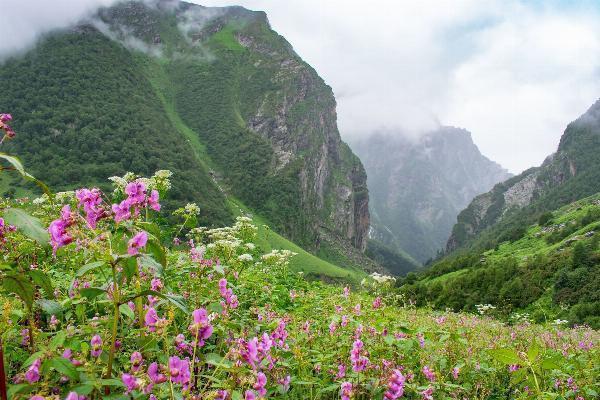A Journey to the Valley of Flowers, Uttarakhand

Strong 8k brings an ultra-HD IPTV experience to your living room and your pocket.
The Valley of Flowers Trek in Uttarakhand, India, is a pilgrimage for nature enthusiasts and adventurers alike. Situated in the Garhwal Himalayas, this UNESCO World Heritage Site attracts visitors with its vibrant alpine meadows, diverse flora, and breathtaking vistas. Embarking on a trek to the Valley of Flowers is not just about traversing picturesque landscapes but also about experiencing the rich biodiversity and natural splendor that this region has to offer.
Introduction to the Valley of Flowers Trek
The Valley of Flowers, renowned for its meadows filled with endemic flowers and rare species, is a testament to nature's bounty. The valley, located at an altitude of 3,658 meters, transforms into a floral spectacle during the monsoon season, making it a must-visit for trekking enthusiasts and nature lovers.
Starting Point and Route
The Valley of Flowers Trek typically commences from the quaint village of Govindghat, which serves as the gateway to the Valley. From Govindghat, trekkers embark on a scenic journey through the Bhyundar Valley, following the course of the Pushpavati River. The trail meanders through dense forests, cascading waterfalls, and terraced fields, offering glimpses of local culture and Himalayan life.
Route Overview
Govindghat to Ghangaria: The trek starts with a drive from Rishikesh to Govindghat, followed by a trek to Ghangaria.
Ghangaria to Valley of Flowers: A day dedicated to exploring the Valley of Flowers.
Optional Hemkund Sahib Excursion: A spiritual and scenic trek to Hemkund Sahib.
Return to Govindghat: The final descent back to the starting point.
Duration and Difficulty
The trek spans approximately 4 to 6 days, depending on the chosen itinerary and pace. It is considered a moderate trek, suitable for both beginners and experienced trekkers. The trail involves gradual ascents, with well-defined paths that allow trekkers to acclimatize to the altitude and enjoy the journey at a leisurely pace.
Day-wise Itinerary of Valley of Flowers Trek
Day 1: Govindghat to Ghangaria
The trek begins with a scenic drive from Rishikesh to Govindghat, followed by a trek to the bustling village of Ghangaria. Ghangaria, situated at an altitude of approximately 9,800 feet, serves as the base camp for the Valley of Flowers and Hemkund Sahib treks. Trekkers can rest and prepare for the upcoming days amidst the serene surroundings of Ghangaria.
Day 2: Ghangaria to Valley of Flowers
The highlight of the trek is exploring the Valley of Flowers itself on the second day. Trekkers set out early in the morning, trekking through alpine meadows adorned with a kaleidoscope of blooming flowers. The Valley comes alive during the monsoon season, with species like the blue poppy, Brahma Kamal, and orchids painting the landscape in vibrant hues. The trek offers opportunities for photography, birdwatching, and soaking in the tranquil ambiance of this natural paradise.
Day 3: Optional Excursion to Hemkund Sahib
For those seeking a spiritual and scenic experience, an optional excursion to Hemkund Sahib is recommended on the third day. Hemkund Sahib, situated at an altitude of around 15,200 feet, is a revered Sikh pilgrimage site surrounded by seven snow-clad peaks. The trek to Hemkund Sahib is steep and challenging but rewards trekkers with breathtaking views of the glacial lake and the surrounding Himalayan panorama.
Day 4: Return to Govindghat
The final day involves descending from Ghangaria to Govindghat, where the trek concludes. Trekkers can reflect on their journey, bid farewell to the Valley of Flowers, and perhaps explore nearby attractions such as the Badrinath Temple or the Mana Village, the last village on the Indian-Tibetan border. The journey back to Rishikesh offers trekkers a chance to reminisce about their experiences and carry fond memories of the Valley of Flowers.
Highlights of Valley of Flowers Trek
Breathtaking Scenery
One of the main attractions of the Valley of Flowers Trek is its breathtaking scenery. Trekkers are treated to panoramic views of snow-capped peaks, verdant valleys, and cascading waterfalls at every turn. The Valley itself is a riot of colors during the monsoon season, with a diverse range of flowers carpeting the landscape in hues of blue, pink, yellow, and red.
Rich Biodiversity
The Valley of Flowers is renowned for its rich biodiversity, housing rare and endemic plant species. Trekkers can encounter medicinal herbs, alpine shrubs, and exotic flowers that thrive in the unique microclimate of the region. The trek offers opportunities for nature enthusiasts to observe and learn about the flora and fauna of the Himalayas firsthand.
Cultural Significance
In addition to its natural beauty, the Valley of Flowers holds cultural significance for indigenous communities and pilgrims. The region is believed to have mythological associations with Hindu deities and is revered as a sacred site by local inhabitants. Trekkers can witness traditional practices and rituals during their journey, gaining insights into the cultural heritage of the Garhwal Himalayas.
Preparation and Essentials
Physical Fitness
Though the trek is moderate, being physically fit will enhance the experience. Regular cardio and strength training can help prepare for the trek.
Gear and Clothing
Proper trekking gear is essential. Sturdy trekking shoes, layered clothing, rain gear, and a comfortable backpack are must-haves. Carrying a good camera is also advisable to capture the stunning vistas.
Permits and Guides
Ensure you have all necessary permits. Hiring a local guide can enhance your trekking experience with valuable insights and ensure safety.
Conclusion
The Valley of Flowers Trek in Uttarakhand is a journey of discovery, adventure, and natural wonder. From the picturesque landscapes and vibrant flora to the cultural richness and spiritual essence, every aspect of the trek leaves a lasting impression on trekkers. Whether you are a nature lover, adventurer, or spiritual seeker, the Valley of Flowers Trek promises an unforgettable experience amidst the splendor of the Himalayas.
Embarking on this trek is not just about walking through beautiful landscapes; it's about connecting with nature, understanding the cultural heritage, and finding peace in the serene environment. The Valley of Flowers is a testament to the beauty and diversity of the Himalayan ecosystem, offering trekkers a once-in-a-lifetime opportunity to witness nature in its most pristine form.
Note: IndiBlogHub features both user-submitted and editorial content. We do not verify third-party contributions. Read our Disclaimer and Privacy Policyfor details.


